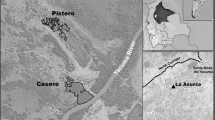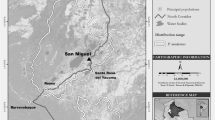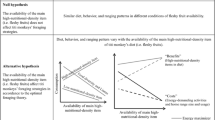Abstract
Previously, wild orangutan feeding and ranging behaviors have been described only from populations in hilly or mountainous regions. The Tanjung Puting study focuses on an orangutan population in a swampy lowland area near sea level. Tanjung Puting also differs from other areas in the virtual absence of large figs, which are significant orangutan food sources elsewhere. During a 4-year period and 6804 hr of observation, focal orangutans were recorded in 11,338 foraging bouts accounting for 3805 hr. Composition and phenology of the forest habitat were documented. The orangutans were predominantly frugivorous, with fruit-eating accounting for 61% of the foraging time. However, the overall variety in their diet was remarkable; 317 different food types have been identified, including fungus, insects, and honey. Orang-utans were strongly opportunistic foragers, with the composition of their diet varying markedly from month to month. During most months orangutans fed on a complex mix of fruit, leaves, bark, insects, and small vines. During some months fruit was not the major component of the diet. All orangutans foraged in both the dry-ground mixed dipterocarp forest and the peatswamp forest habitats found in their ranges. Adult males and females utilized different proportions of certain resources in their diets. Prime adult males also ranged further per day and spent more time on the ground than prime adult females. At Tanjung Puting contact with other orangutans usually increased a focal orangutan’s day length, day range, and amount of time spent moving. This suggests that foraging alone maximized each orangutan’s foraging returns by minimizing the day range traveled. Orangutan solitariness is the result of a large body size and of a predominantly frugivorous and opportunistic diet.
Similar content being viewed by others
References
Altmann, J. (1974). Observational study of behavior: Sampling methods.Behaviour 49: 227–267.
Davenport, R. (1967). The orang-utan in Sabah.Folia primatol. 5: 247–263.
Galdikas, B. M. F. (1979). Orangutan adaptation at Tanjung Puting Reserve: Mating and ecology. In Hamburg, D. A., and McCown, E. R. (eds.),The Great Apes, Benjamin/Cummings, Menlo Park, Calif., pp. 194–233.
Galdikas, B. M. F. (1982). Orangutans as seed dispersers at Tanjung Puting, Central Kalimantan: Implications for conservation. In de Boer, L. E. M. (ed.),The Orangutan. Its Biology and Conservation, Dr. W. Junk, The Hague.
Galdikas, B. M. F. (1985). Orangutan sociality at Tanjung Puting.Am. J. Primatol. 9: 101–119.
Horr, D. A. (1975). The Borneo orangutan: Population structure and dynamics in relationship to ecology and reproductive strategy. In Rosenblaum, L. A. (ed.),Primate Behaviour: Developments in Field and Laboratory Research, Vol. 4, Academic Press, New York, pp. 307–323.
MacKinnon, J. (1971). The orang-utan in Sabah today.Oryx 11: 141–191.
MacKinnon, J. (1974). The behaviour and ecology of wild orangutans (Pongo pygmaeus).Anim. Behav. 22: 2–74.
Rijksen, H. D. (1978).A Field Study on Sumatran Orangutans (Pongo pygmaeus abelii Lesson 1827): Ecology, Behaviour and Conservation, Veenman and Zonen, Wageningen.
Rodman, P. S. (1973). Population composition and adaptive organization among orangutans of the Kutai Reserve. In Michael, J. H., and Crook, J. H. (eds.),Comparative Ecology and Behaviour of Primates, Academic Press, London, pp. 171–209.
Rodman, P. S. (1977). Feeding behaviour of orang-utans of the Kutai Nature Reserve, East Kalimantan. In Clutton-Brock, T. H. (ed.),Primate Ecology: Studies of Feeding and Ranging Behaviour in Lemurs, Monkeys and Apes, Academic Press, London, pp. 383–413.
Rodman, P. S. (1979). Individual activity patterns and the solitary nature of orangutans. In Hamburg, D. A., and McCown, E. R. (eds.),The Great Apes, Benjamin/Cummings, Menlo Park, Calif., pp. 234–255.
Wallace, A. R. (1869).The Malay Archipelago, Macmillan, London.
Wrangham, R. W. (1979). On the evolution of ape social systems.Soc. Sci. Inform. 18: 335–368.
Author information
Authors and Affiliations
Rights and permissions
About this article
Cite this article
Galdikas, B.M.F. Orangutan diet, range, and activity at Tanjung Puting, Central Borneo. Int J Primatol 9, 1–35 (1988). https://doi.org/10.1007/BF02740195
Received:
Revised:
Issue Date:
DOI: https://doi.org/10.1007/BF02740195




